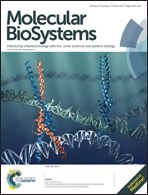Small RNA sequencing revealed dysregulated piRNAs in Alzheimer's disease and their probable role in pathogenesis†
Abstract
PIWI-interacting RNAs (piRNAs), ∼23–36 nucleotide-long small non-coding RNAs, earlier believed to be germline-specific, have now been identified in somatic cells including neural cells. However, piRNAs have not yet been studied in the human brain (HB) and Alzheimer's disease (AD)-affected brain. In this study, by next-generation small RNA sequencing, 564 and 451 piRNAs were identified in the HB and AD-affected brain respectively. The majority of the neuronal piRNAs have intronic origin wherein primary piRNAs are mostly from the negative strand. piRNAs originating from the coding sequence of mRNAs and tRNAs are highly conserved compared to other genomic contexts. We found 1923 mRNAs significantly down-regulated in AD as the predicted targets of 125 up-regulated piRNAs. The filtering of targets based on our criteria coupled with pathway enrichment analysis of all the predicted targets resulted in five most significant AD-associated pathways enriched with four genes (CYCS, LIN7C, KPNA6, and RAB11A) found to be regulated by four piRNAs. The qRT–PCR study verified the reciprocal expression of piRNAs and their targets. This study provides the first evidence of piRNAs in the HB and AD which will provide the foundation for future studies to unravel the regulatory role of piRNAs in the human brain and associated diseases. The sequencing data have been submitted to the GEO database (Accession no. GSE85075).



 Please wait while we load your content...
Please wait while we load your content...